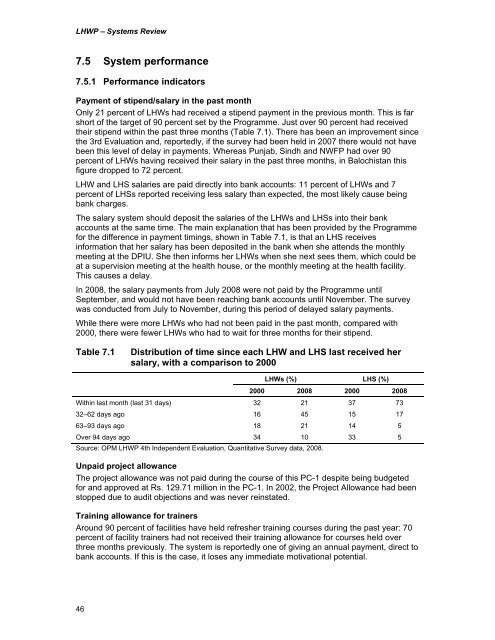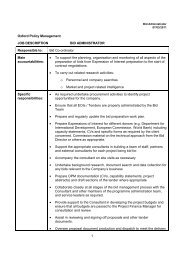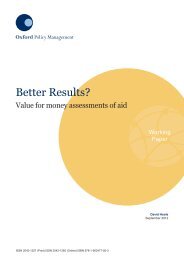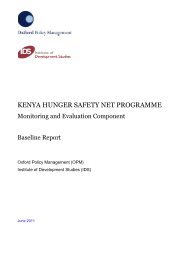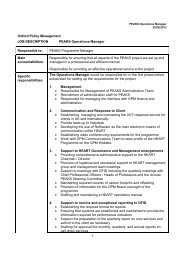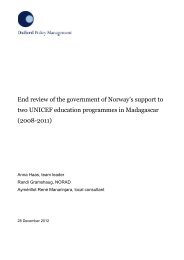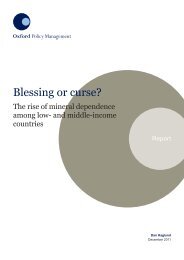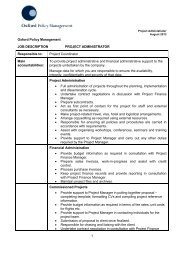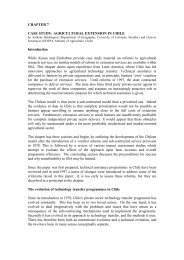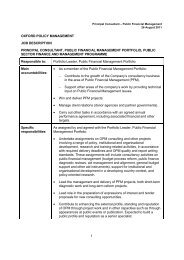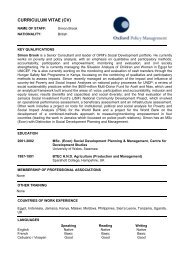LHW Systems Review - Oxford Policy Management
LHW Systems Review - Oxford Policy Management
LHW Systems Review - Oxford Policy Management
You also want an ePaper? Increase the reach of your titles
YUMPU automatically turns print PDFs into web optimized ePapers that Google loves.
<strong>LHW</strong>P – <strong>Systems</strong> <strong>Review</strong>7.5 System performance7.5.1 Performance indicatorsPayment of stipend/salary in the past monthOnly 21 percent of <strong>LHW</strong>s had received a stipend payment in the previous month. This is farshort of the target of 90 percent set by the Programme. Just over 90 percent had receivedtheir stipend within the past three months (Table 7.1). There has been an improvement sincethe 3rd Evaluation and, reportedly, if the survey had been held in 2007 there would not havebeen this level of delay in payments. Whereas Punjab, Sindh and NWFP had over 90percent of <strong>LHW</strong>s having received their salary in the past three months, in Balochistan thisfigure dropped to 72 percent.<strong>LHW</strong> and LHS salaries are paid directly into bank accounts: 11 percent of <strong>LHW</strong>s and 7percent of LHSs reported receiving less salary than expected, the most likely cause beingbank charges.The salary system should deposit the salaries of the <strong>LHW</strong>s and LHSs into their bankaccounts at the same time. The main explanation that has been provided by the Programmefor the difference in payment timings, shown in Table 7.1, is that an LHS receivesinformation that her salary has been deposited in the bank when she attends the monthlymeeting at the DPIU. She then informs her <strong>LHW</strong>s when she next sees them, which could beat a supervision meeting at the health house, or the monthly meeting at the health facility.This causes a delay.In 2008, the salary payments from July 2008 were not paid by the Programme untilSeptember, and would not have been reaching bank accounts until November. The surveywas conducted from July to November, during this period of delayed salary payments.While there were more <strong>LHW</strong>s who had not been paid in the past month, compared with2000, there were fewer <strong>LHW</strong>s who had to wait for three months for their stipend.Table 7.1Distribution of time since each <strong>LHW</strong> and LHS last received hersalary, with a comparison to 2000<strong>LHW</strong>s (%) LHS (%)2000 2008 2000 2008Within last month (last 31 days) 32 21 37 7332–62 days ago 16 45 15 1763–93 days ago 18 21 14 5Over 94 days ago 34 10 33 5Source: OPM <strong>LHW</strong>P 4th Independent Evaluation, Quantitative Survey data, 2008.Unpaid project allowanceThe project allowance was not paid during the course of this PC-1 despite being budgetedfor and approved at Rs. 129.71 million in the PC-1. In 2002, the Project Allowance had beenstopped due to audit objections and was never reinstated.Training allowance for trainersAround 90 percent of facilities have held refresher training courses during the past year: 70percent of facility trainers had not received their training allowance for courses held overthree months previously. The system is reportedly one of giving an annual payment, direct tobank accounts. If this is the case, it loses any immediate motivational potential.46


